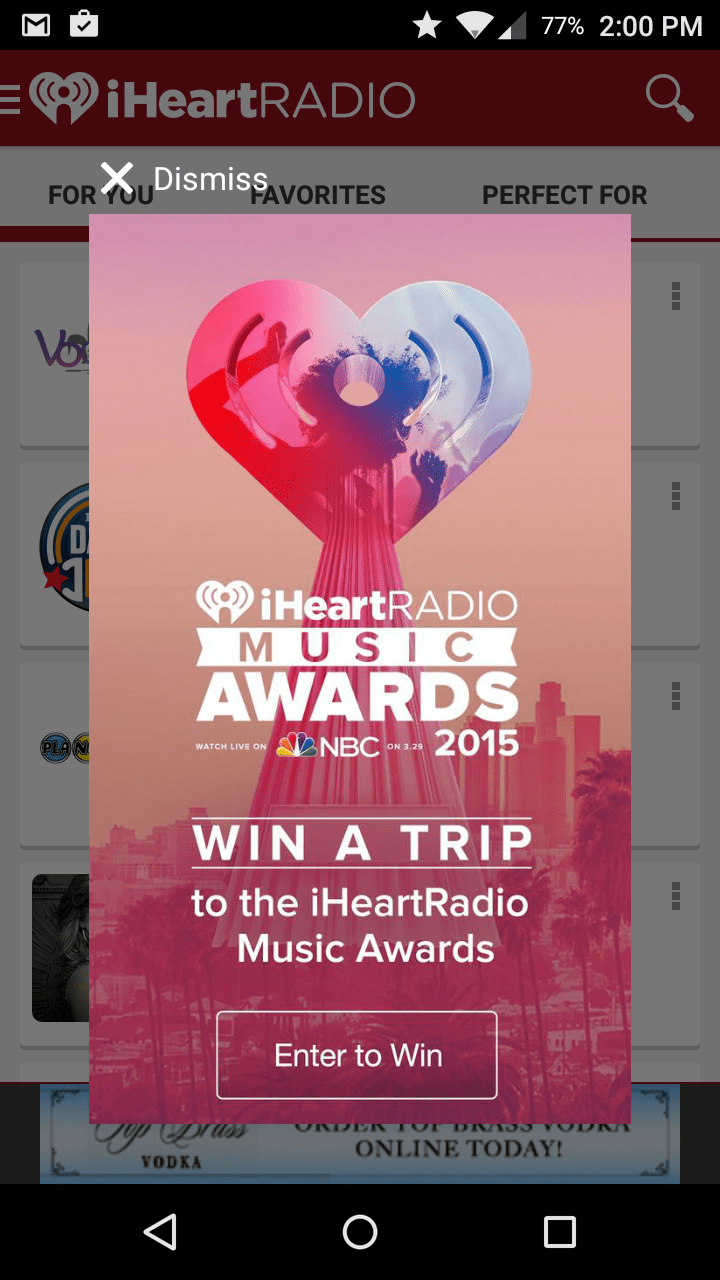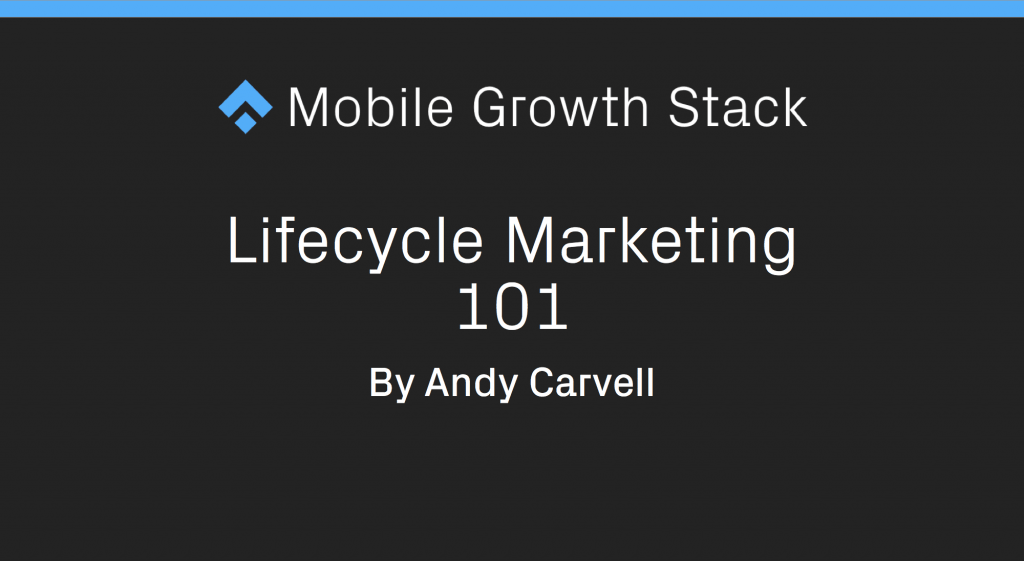
In this post, I’ll give a short introduction to the huge topic of lifecycle marketing and discuss how to build a lifecycle marketing program from scratch.
What Exactly Is Lifecycle Marketing?
The term lifecycle refers to the stages a user goes through as they interact with a product over time. This is sometimes referred to as the user journey.
Every user experiences the product in their own way and form their own opinions about its value to them. Some people will become loyal, regular users while others will abandon the product after trying it just once. Some users will become paying customers, invite their friends to try out the product, or perform other valuable actions, while others will become dormant. In an ideal world, as many users as possible will have a great experience with the app and continue on the journey towards being valuable, engaged users.
Lifecycle Marketing refers to activities that provide targeted interactions with users to help them through the stages of their lifecycle, typically employing some combination of channels such as email, push notifications, and mobile in-app messages. In some scenarios, other channels such as SMS, chatbots, re-targeting the user in other apps, etc. also prove effective.
A lifecycle marketing program can be built up in stages. Typically the steps involved would be:
- Mapping out the ideal user journey(s)
- Defining an initial set of hypotheses that can be tested with lifecycle campaigns aimed at nudging them along the way towards the ideal user journey with well-timed messaging
- Identifying users who are at specific points in their user journey
- Delivering the campaigns to these users and measuring the results
- Refining your understanding of the user journey by iterating on campaigns as hypotheses are proven / disproven by the results.
- Experiment with new campaigns to keep building engagement
Start simple, and improve iteratively
Lifecycle marketing is an ongoing process of refinement. It’s advisable to go step by step when setting up and testing initial campaigns, rather than trying to implement a full set of interactions from the outset; many initial assumptions about the best way to influence user behavior will be wrong and many elements of each campaign (copy, timing, segmentation, choice of channel) will have plenty of room for improvement.
Mapping Out The Ideal User Journey
Although each user is unique, the product developer should have a clear idea of what constitutes an ideal user journey. There may be more than one type of ideal user and hence more than one ideal user journey. For example, in a marketplace, there are buyers and sellers, both critical to the ecosystem but with radically different characteristics and engagement patterns. In this case, there would be at least two ideal user journeys: one for the ideal buyer and one for the ideal seller.
Developing a realistic understanding of an ideal user journey is different from simply imagining what a hypothetical perfect user would do. Careful analysis of real user behavior will lead to a deeper understanding of what differentiates valuable, engaged users from disengaged or churning users. Even before the product is live with real users, observation of test subjects via qualitative user testing can help to identify key points in a successful user experience, as well as key stumbling blocks or areas of confusion that might be improved through product changes or lifecycle communications. Mapping out the user journey ahead of time also helps identify which events and user attributes should be tracked in the analytics/marketing stack. Once the product is live, analytics data provides a wealth of information about user behavior that can be analyzed to better understand what constitutes the ideal user journey.
It’s helpful to break the user journey down into distinct stages or milestones. Here’s a hypothetical example for a fictional app, GenericApp, in which users can browse, bookmark and watch video content, with the option to purchase various upgrades (such as the ability to download videos for offline watching, remove advertising, etc.) in the form of in-app purchases.
User journey: key milestones
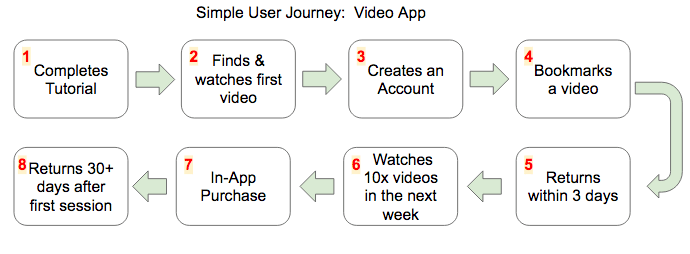
These milestones reflect a pretty ideal situation for the fictional app developer; it’s likely a user that achieved all of these things in their first 30 days would have had a positive experience with the app and return for more sessions (and possibly purchases) throughout their lifetime. Even if they churn, they will have delivered some value from the IAP. It should be noted that it’s not reasonable to expect a high percentage of users to make purchases… in games, for example, it’s typically 5% or less of users that can be successfully monetized through IAP.
While not all users will make it through this engagement funnel or may take differing amounts of time to reach certain milestones, it’s still useful to have the ideal user journey as a target and to understand which actions within the app deliver value (either monetarily or because they are good predictors of higher retention). While these milestones would ideally be informed by some strong data analysis (e.g. running a regression to see which actions are the best predictors of retention / monetization), there is value in setting and optimizing toward targets (e.g. 10x video views in the first week) even if they are not scientifically derived.
The milestones themselves — and the methods used to nudge users towards them — will evolve over time as a greater understanding of user behavior and mindset at each stage of the funnel is achieved, through testing hypotheses either through A/B tests on campaigns, polling/surveying users, or through further user testing. It’s better to start somewhere with clear — if imperfect — goals, than just fire out emails and push notifications with a nonspecific goal of increasing engagement.
Defining Initial Hypotheses And Campaigns To Test Them
Now that the ideal user journey is mapped out, the fun begins: what campaigns might help users hit the milestones defined?
Consider Reach: Start At The Beginning Of The User Journey
When starting from scratch, it’s highly advisable to focus on the new user experience (i.e. the start of the user journey), since this is where the majority of users will drop off and churn. A campaign aimed at increasing conversion to in-app purchases may deliver monetary value, but the reach of such a campaign will be several orders of magnitude smaller than an onboarding campaign targeting new users. Firstly improving new user retention will, over time, increase the audience for monetization-based campaigns further down the funnel, as well as delivering compound growth in the userbase.
In the hypothetical user journey of our fictional video app, some initial milestones include completing the interactive tutorial (which hopefully gives the user a better sense of what the product is about and how to use it), discovering and watching at least one video (hopefully enjoying it), and registering for an account.
Since this fictional app does not force a user to create an account before trying out the app, it’s important to note that until the user completes this step, their email address is not yet collected, and hence email as a channel is not available. Since this channel could magnify the impact of future lifecycle campaigns, it’s a great idea to drive as many people to create accounts early on with the channels available.
A set of initial hypotheses might look something like this:
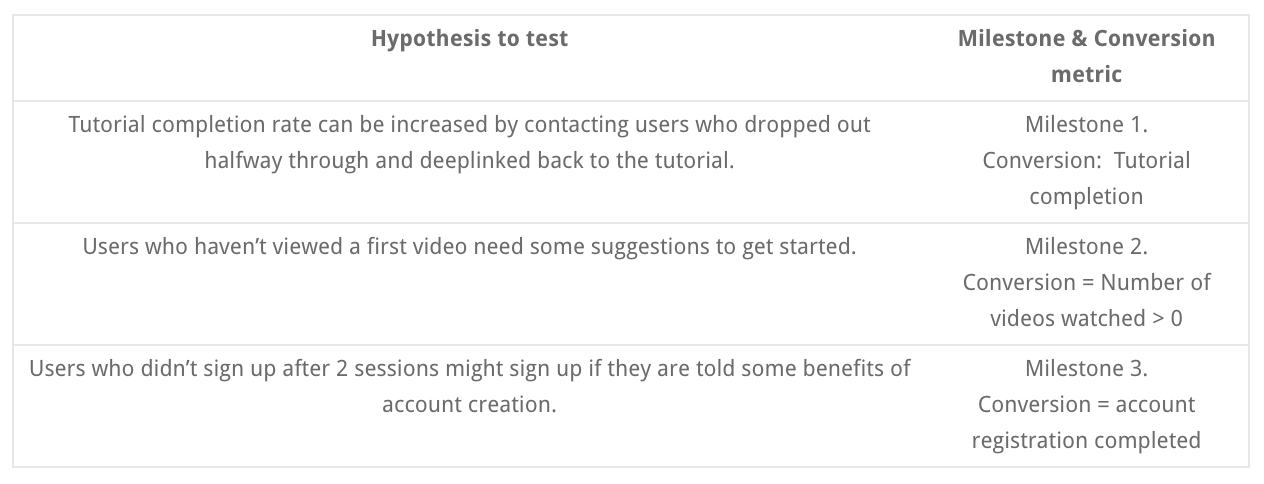
With just these three basic hypotheses, there are plenty of options for initial test campaigns and variants.
Each of these hypotheses could fairly swiftly be tested with a push notification (for users outside of the app), an in-app message (for users who return to the app for another session), or a combination (i.e. use a push to bring users back to the app, then show all relevant users — whether pushed or not — the in-app message on their next session). In-app messages are great, because they don’t require opt-in from the user (unlike push), but they only work for users already in the app.
Setting Up The First Test Campaign
It’s useful to test just one thing at a time and — if a hypothesis has been proven — invest in further rounds of testing to improve results. Considering the overall reach of each channel, I would start with an in-app message (reaches 100% of target audience on their next in-app session), prompting users to return to the tutorial with a call to action that triggers the tutorial to restart/resume via a deep-link.
If the in-app message is driving more users to the conversion goal (and hence proving the high-level hypothesis), it could likely be improved further with a push notification for users who haven’t yet seen the in-app to bring them back in, but this could be a stage 2 optimization.
Defining The Audience Segment
The target audience segment for the first milestone is relatively straightforward: all users who haven’t completed the tutorial (and haven’t yet watched a video). The bracketed clause is in place to avoid spamming users who are already engaging despite not completing the tutorial. Targeting criteria are valid parameters to test, of course, so shouldn’t be assumed to be perfect on the first run.
Defining Initial Channel(S)
In this example, to keep it simple, I’m going with an in-app message. If this doesn’t outperform the control group, we could test other channels, or declare the hypothesis disproved and move on to a new idea.
Defining Initial Messaging: Format, Creative & Copy Variants
In this step, an initial variant or variants should be created of what the user would be shown. In the case of push notifications, this might be as simple as one line of short text. For emails or in-app messages, more visual formatting options are available.
Multivariate tests increase the pace of iteration towards a conclusion regarding the hypothesis.
Given that the initial objective is to test the hypothesis, it can be argued that keeping things as simple as possible is best. That being said, if there are enough new users in each daily cohort that a statistically significant multivariate test could be conducted in a reasonable timeframe, testing multiple variants of the copy or design (but not both at the same time!) provides more chances for the hypothesis to be proved by one or more of the variants, and could indicate a clear winner that would provide a direction for further optimization. If just one variant is tested and does not perform, the team will need to decide whether this was down to using the wrong messaging (and hence deserves another round of testing), or that the hypothesis is clearly false i.e. whether the main hypothesis was false, or whether the approach used was the wrong one to prove the hypothesis.
Even in our example in-app message, there are multiple variables that could be tested:
- Design
- Copy
- Call-to-Action (CTA)
For a first iteration, I would advocate keeping things relatively simple and testing 1–4 copy variants, with a single fixed design / out-of-the-box template. If none of the variants outperformed the control group (a holdout group that does not receive the message at all), I might test a couple of different CTAs or designs. If the second round still fails to significantly out-perform the control, it’s probably time to declare the hypothesis disproved and think about a new way to increase tutorial completion (including product-based options such as forcing users to complete the tutorial before continuing).
Instrumentation For The Test
Before running any variants of the test, measurement needs to be in place to accurately identify and count the users served each test variant and the control group (who are not served a message). In addition, it must be possible to discern whether a user converted (in this case, completed the tutorial), by ensuring that the conversion event is tracked. Note that using a control group allows post-facto analysis of many different behavioral factors, including checking whether the test group were more likely to complete a specific action, were better retained, etc.
Mobile Marketing Automation frameworks massively simplify this task,but it’s perfectly possible to set up this instrumentation around campaigns internally using engineering work. The important thing is that everything is tracked and that new campaigns and test variants can be quickly configured, enabling rapid iteration.
Running The Test
The test should be run for long enough to generate a statistically significant result. If the result is positive (i.e. one or more variants outperforms the control), it would be advisable to put the winning variant into production (i.e. serving it constantly to new users who qualify for the target segment) so that it’s delivering impact while a new test is being devised.
Watch Out For Negative Side-Effects
Note that the risk of over-communicating with the user increases with every new campaign created… there is a risk of diminishing returns and of user abandonment or opt-outs whenever a user is contacted in a way that they deem intrusive or unnecessary.
Keeping an eye on potential negative influences on metrics such as opt-in rates (for push and email), user complaints via customer service, and user churn will help identify when users are being over-communicated with. However, most firms start out with too cautious an approach here; let the data inform any decision to scale back lifecycle comms, rather than anecdotal evidence or fear. Above all, ensure that lifecycle campaigns are well targeted (i.e. relevant) and valuable to the user, as evidenced by subsequent increased engagement.
Next Steps
If the hypothesis was proved and a lifecycle campaign has been shown to increase impact / get more users to complete a milestone, it’s likely that further optimizations can be made by experimenting with:
- Timing
- Targeting
- Copy & Creative
- Channel mix
The upside of running further experiments will need to be weighed carefully against the opportunity to create new campaigns for other lifecycle stages or milestones. The team should also be open to the possibility that they are optimizing for a local maxima when a bigger win could be achieved with a radically different approach (e.g. removing the tutorial altogether and providing suggested content in the app on the very first screen).
Lifecycle campaigns are limited only by your creativity and — in certain cases — the level of technical integration required to insert or aggregate dynamic and personalized content. Lifecycle marketing can be used to drive regular engagement, to re-activate users who have stopped using the product, to advertise special offers, promote seasonal content, inform users about new features… the list is endless!
Some Strong Examples Of Lifecycle Campaigns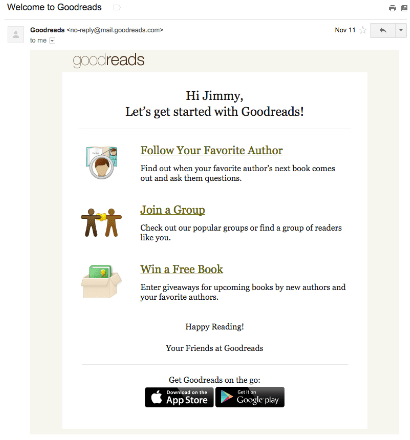
Goodreads compliments its in-app onboarding with a welcome email.
Endomondo delivers monthly ‘digest’ emails to remind & encourage users to keep tracking their workouts.
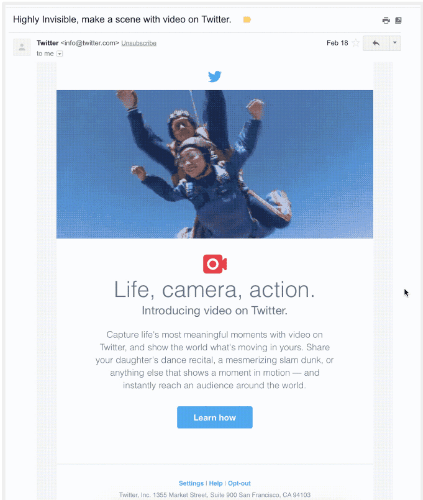
A new feature announcement from Twitter.

A Tinder push notification re-activates users by playing on FOMO (Fear of Missing Out) psychology.
iHeartRadio uses a modal in-app message to run a promotion.
Summary
This article scratches the surface of what it takes to build and operate a successful lifecycle marketing program. A strong program will start with a good understanding of and empathy with the typical user as they interact with the product at increasing levels of fluency and engagement. While mobile marketing automation frameworks can save a great deal of time & effort when building out a lifecycle marketing program, the tools used are not as essential as the methodology practiced and a meticulous focus on impact.
When implementing a lifecycle program, consider the reach of each campaign (onboarding has more upside than anything that comes later, when many users have already churned) and the mix of channels that could be used to deliver the message. As with any growth activity, ensure the correct instrumentation is in place to measure the impact of campaigns, be ready to iterate towards greater impact and keep an eye on opt-in rates.
In future articles, I will cover some specifics of the channels available to mobile marketers, dive deeper into campaign measurement, and explain how to implement a personalized activity notification system. If you have specific requests or questions, please let me know by leaving a comment in the section below.

